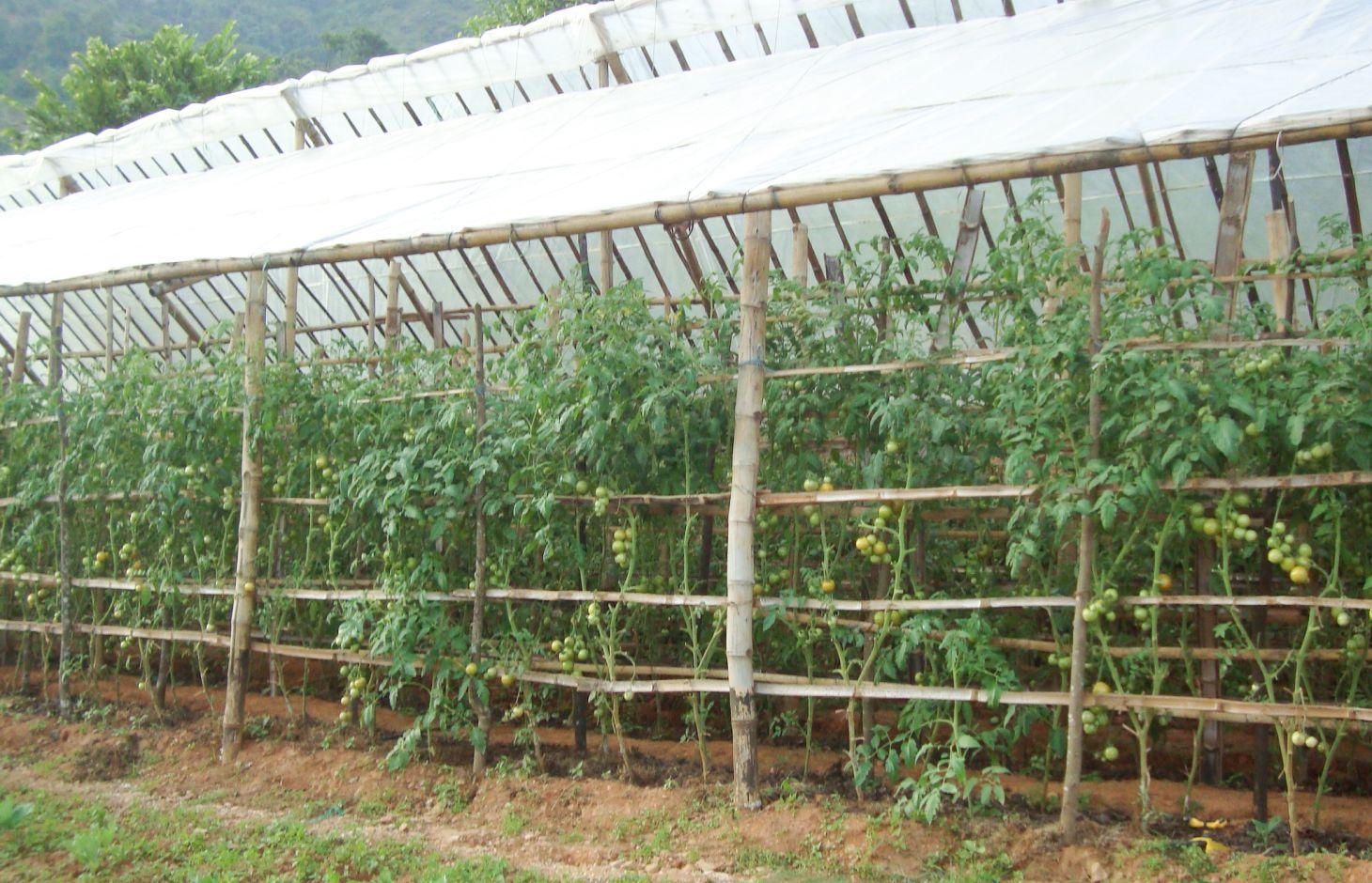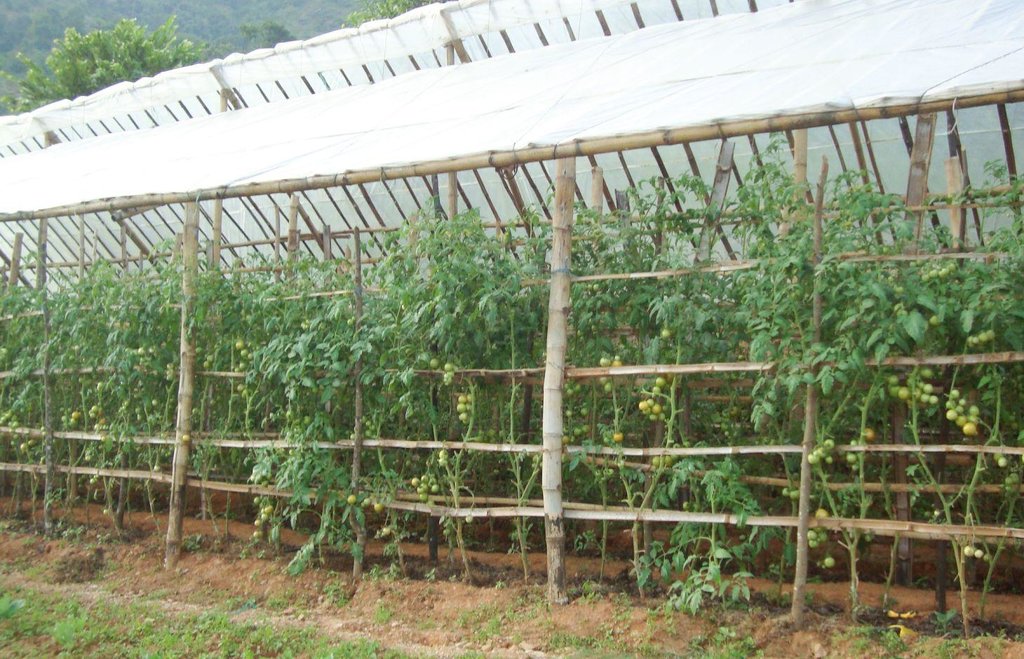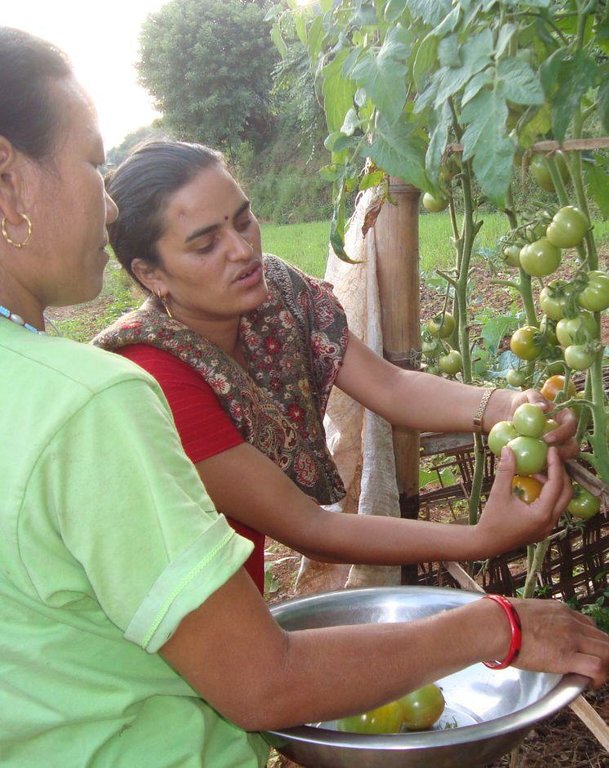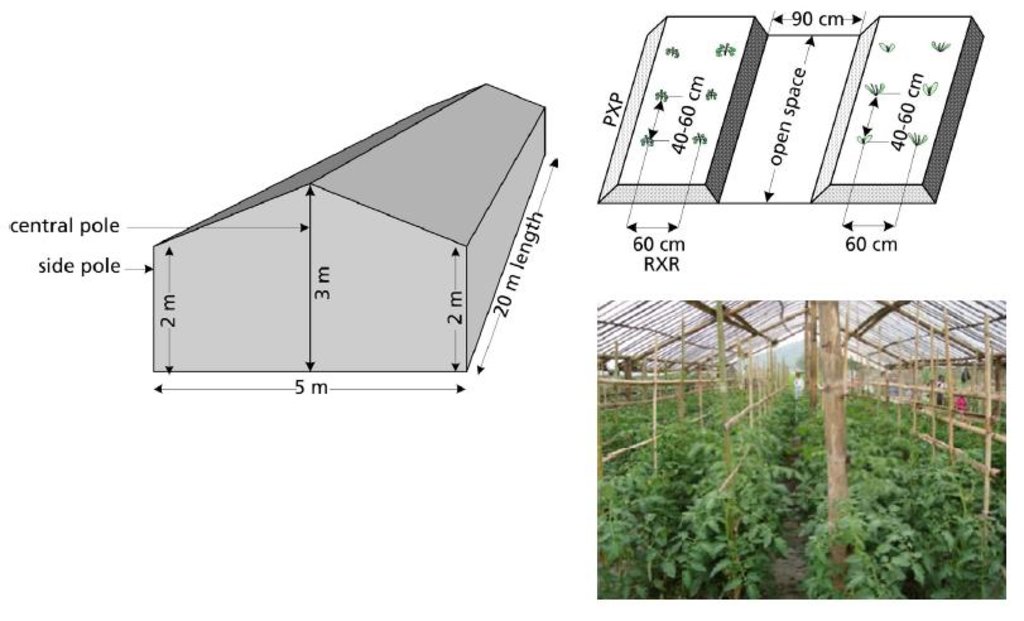A low-cost polyhouse for tomato production in the rainy season [Непал]
- Шинийг нээх:
- Шинэчлэх:
- Эмхэтгэгч: Shreedip Sigdel
- Хянан тохиолдуулагч: –
- Хянагч: David Streiff
Sasto Plastic ghar ma barsha golbheda kheti (Main Contributor: Bishnu Bishwakarma, Helvetas Nepal)
technologies_1688 - Непал
Бүлгүүдийг үзэх
Бүгдийг дэлгэх Бүгдийг хаах1. Ерөнхий мэдээлэл
1.2 Технологийг үнэлэх, баримтжуулах ажилд хамаарах мэдээлэл өгсөн хүмүүс, байгууллагуудын холбоо барих мэдээлэл
Газар ашиглагч:
Технологи баримтжуулах/үнэлэх ажилд дэмжлэг үзүүлсэн байгууллага(ууд)-ын нэр (шаардлагатай бол)
HELVETAS (Swiss Intercooperation)Технологи баримтжуулах/үнэлэх ажилд дэмжлэг үзүүлсэн байгууллага(ууд)-ын нэр (шаардлагатай бол)
ICIMOD International Centre for Integrated Mountain Development (ICIMOD) - Непал1.3 ВОКАТ-аар баримтжуулсан өгөгдлийг ашиглахтай холбоотой нөхцөл
Мэдээллийг хэзээ (газар дээр нь) цуглуулсан бэ?
01/03/2013
Эмхэтгэгч болон гол мэдээлэгч хүн(хүмүүс) WOCAT аргачлалаар баримтжуулсан мэдээллийг ашиглахтай холбоотой нөхцлийг хүлээн зөвшөөрсөн:
Тийм
2. ГТМ Технологийн тодорхойлолт
2.1 Технологийн товч тодорхойлолт
Технологийн тодорхойлолт:
Smallholder farmers can use polyhouses to produce high demand vegetables, such as tomatoes, and can earn a substantial income from even a relatively small plot of land in a short time.
2.2 Технологийн дэлгэрэнгүй тодорхойлолт
Тодорхойлолт:
During the wet season (June–October), the monsoon rains severely limit the type of crops that can be grown in open fields and they also restrict the production of seedlings. Low-cost polyhouses can be used to protect crops from excessive rainfall and can provide a sheltered environment for the production of better quality crops over the rainy season cropping period. For example, smallholder farmers who produce high demand vegetables such as tomatoes can earn as much as USD 350–500 from a plot of land which measures only 100 m2 in area over the short time period from June to November. This is much more than they can earn by growing any traditional crop by conventional methods. The Sustainable Soil Management Programme (SSMP) is promoting this technology in several mid-hill districts of Nepal.
Establishment / maintenance activities and inputs: Polyhouses should be situated in well-drained areas where sunshine is abundant and there is no shade throughout the cropping period. The bamboo frame can be constructed earlier in the year but the plastic roofing is not added until after one or two rainfall events. The height of the polyhouse frame varies depending on the altitude. At higher elevations, the polyhouses are lower to help trap more heat and moisture, whereas at lower elevations the polyhouses are higher to allow more air to circulate and moisture to evaporate. The preparations, which take place mid-May to early June, consist of fertilizing the soil and planting the tomato seedlings. Throughout the growing season the tomato plants are staked, trained, and pruned and a top dressing of fertilizer is added to produce a higher quality product.
2.3 Технологийн гэрэл зураг
2.5 Энэ үнэлгээнд хамрагдсан технологийг хэрэгжүүлсэн улс орон/ бүс нутаг/ байршил
Улс:
Непал
Байршлын дэлгэрэнгүй тодорхойлолт:
Mid Hills of Nepal
2.7 Технологийн танилцуулга
Технологийг хэрхэн нэвтрүүлснийг тодорхойл:
- Гадны төсөл/хөтөлбөрийн дэмжлэгтэйгээр
3. ГТМ технологийн ангилал
3.1 Технологийн үндсэн зорилго (ууд)
- үйлдвэрлэлийг сайжруулах
- үр ашигтай эдийн засгийн нөлөөг бий болгох
3.2 Технологи нэвтрүүлсэн газрын одоогийн газар ашиглалтын хэлбэр(үүд)

Тариалангийн талбай
- Нэг наст үр тариа
Тайлбар:
Major land use problems (compiler’s opinion): In the mid-hills of Nepal, the arable land of most farm households has been divided into very small plots. If this land is used to produce traditional crops such as maize, wheat, and millet using conventional farming methods, it cannot provide full employment for all of the householders and cannot yield sufficient cash income for the household. The risk of intense rainfall during the monsoon season, which can damage crops, has prevented these farmers from switching to more lucrative high value crops.
3.3 Газар ашиглалтын тухай нэмэлт мэдээлэл
Жилд ургамал ургах улирлын тоо:
- 1
Тодорхойлно уу:
Longest growing period in days: 214; Longest growing period from month to month: May to November
3.4 Технологи ГТМ-ийн аль бүлэгт хамаарах вэ
- Greenhouses
3.5 Технологийн хамрах талбай
Технологи өргөн дэлгэрсэн эсхийг тодорхойл:
- газар дээр жигд тархсан
Технологи газар нутгийн хэмжээнд жигд тархсан бол түүний эзлэх талбайг дундажаар тооцож тэмдэглэ:
- 1-10 км2
3.6 Технологийг бүрдүүлэх ГТМ арга хэмжээ

Агрономийн арга хэмжээ
- А6: Бусад
3.7 Технологид харгалзах газрын доройтлын төрөл

хөрс усаар эвдрэх
- Wt: Хөрсний гадаргын угаагдал
Тайлбар:
Main causes of degradation: Heavy / extreme rainfall (intensity/amounts) (During the summer monsoon (June-October), continuous or heavy rainfall can damage seedlings and erode the land; it is difficult to establish crops during this time.)
3.8 Газрын доройтлоос урьдчилан сэргийлэх, сааруулах ба нөхөн сэргээх
Газрын доройтолтой холбоотойгоор Технологи ямар зорилго тавьсан болохыг тодорхойл:
- газрын доройтлоос урьдчилан сэргийлэх
4. Техникийн нөхцөл, хэрэгжүүлсэн үйл ажиллагаа, материал ба зардал
4.1 Технологийн техник зураг
4.2 Техникийн үзүүлэлт/ техникийн зургийн тайлбар
Left: Sketch of a polyhouse. The optimum length is 20 m and the width 5 m. The height of the central and side poles varies depending on the elevation. Note that there should be a space of at least 1 m between polyhouses.
Right top: Cross sectional view of a planting bed showing row-to-row (RXR) and plant-to-plant (PXP) distances. Note that there should be a space of at least 90 cm between beds.
Right bottom: Inside the polyhouse, the tomatoes can be staked using bamboo poles; the plants are trained along these trellises.
Technical knowledge required for land users: moderate
Main technical functions: Increase Productivity, Introduce high value crop
Secondary technical functions: increase in nutrient availability (supply, recycling,…)
4.3 Материал болон зардалд хамаарах ерөнхий мэдээлэл
Үнэ өртөг, оруулсан хувь нэмрийг хэрхэн тооцсоныг тодорхойл:
- Технологийн нэгж тус бүр
Нэгжийг тодорхойл:
Polyhouse
Үнэ өртөгийг тооцоход ашигласан мөнгөн нэгж:
- Америк доллар
Хөлсний ажилчны нэг өдрийн цалингийн хэмжээг тодорхойлно уу:
4
4.4 Бий болгох үйл ажиллагаа
| Үйл ажиллагаа | Арга хэмжээний төрөл | Хугацаа | |
|---|---|---|---|
| 1. | Labour for construction of the Polyhouse | Барилга байгууламжийн | |
| 2. | Labour for planting, training,pruning,stalking | Агрономийн | |
| 3. | Materials: Bamboo pole, plastics sheet, rope, nails, seed, poles | ||
| 4. | Agricultural: seed, fertilizer, crop protection | Агрономийн |
Тайлбар:
Details for the establishment of Poly house. Establishment activities 1. Construction of the polyhouse using bamboo poles, wooden posts, clear plastic sheet, nails, and rope. 2. How long it takes to construct the polyhouse and plant the crops depends on how much labour is available. Depending on their level of expertise, four to five people can construct the structure in one day; and two people can complete the soil preparation and planting in one day. Technical guidelines for erecting a polyhouse The optimum length of a polyhouse is 20 m, and the width is 5 m; 400–500 gauge plastic sheeting is used. The height of the polyhouse depends on the elevation: at 1200–1600 masl, the optimum height of the central pole is 3 m and the side poles are 2 m high; at 1600–2000 masl, the central pole is 2.5 m high and the side poles are 1.6 m high. There should be an open space of at least 1 m between polyhouses. Technical guidelines for preparing the soil and planting tomatoes Per plant, at least 3–4 kg of well-decomposed farmyard manure and compost are worked into the soil. Before transplanting the seedlings, the soil around each is dressed with 10 g of DAP (diammonium phosphate) and 6 g of MoP (muriate of potash). The seedlings are transplanted when they are 20–25 days old. In an open row system, the suggested row to row (RxR) spacing is 90 cm and the suggested plant to plant (PxP) spacing is 60 cm; in a closed row system the row to row and plant to plant spacing can both be 60 cm. At least two top dressings of DAP and MoP (10:10 g) are necessary 20–25 and 40–45 days after transplanting; 1 kg per 0.05 ha of borax is also added at the time of the first top dressing. Alternatively, these two top dressings can be substituted by a mixture of cattle urine (50 ml) and water (200 ml water) per plant. The dressing with this mixture can begin 20–25 days after transplanting, and is repeated every 10–12 days.
4.5 Бий болгоход шаардагдсан зардал, хөрөнгийн өртөг
| Зардлын нэр, төрөл | Хэмжих нэгж | Тоо хэмжээ | Нэгжийн үнэ | Зардал бүрийн нийт өртөг | Нийт дүнгээс газар ашиглагчийн төлсөн % | |
|---|---|---|---|---|---|---|
| Хөдөлмөр эрхлэлт | Construction of the polyhouse | persons/unit | 5.0 | 4.0 | 20.0 | 100.0 |
| Хөдөлмөр эрхлэлт | Training, pruning, stalking | persons/unit | 5.0 | 4.0 | 20.0 | 100.0 |
| таримал материал | Seed, fertilizer, crop protection | unit | 1.0 | 10.0 | 10.0 | 50.0 |
| Барилгын материал | Bamboo pole, plastics sheet, rope, nails, seed, poles | unit | 1.0 | 90.0 | 90.0 | 35.0 |
| Технологи бий болгох нийт үнэ өртөг | 140.0 | |||||
4.6 Арчилгаа/ урсгал үйл ажиллагаа
| Үйл ажиллагаа | Арга хэмжээний төрөл | Хугацаа/ давтамж | |
|---|---|---|---|
| 1. | There are no major maintenance costs during the cropping season; but occasionally some minor maintenance is required (e.g., replacing damaged stakes and plastic sheet, or securing with additional rope and nails). | Агрономийн |
4.7 Арчилгаа/урсгал ажилд шаардагдсан зардал, хөрөнгийн өртөг (нэг жилд)
| Зардлын нэр, төрөл | Хэмжих нэгж | Тоо хэмжээ | Нэгжийн үнэ | Зардал бүрийн нийт өртөг | Нийт дүнгээс газар ашиглагчийн төлсөн % | |
|---|---|---|---|---|---|---|
| Хөдөлмөр эрхлэлт | Maintenance | persons/unit | 1.0 | 5.0 | 5.0 | 100.0 |
| Тоног төхөөрөмж | Equipment | unit | 1.0 | 5.0 | 5.0 | 100.0 |
| Бордоо ба биоцид | Agricultural | unit | 1.0 | 5.0 | 5.0 | 100.0 |
| Барилгын материал | Material | unit | 1.0 | 10.0 | 10.0 | 100.0 |
| Технологийн арчилгаа/урсгал үйл ажиллагаанд шаардагдах нийт үнэ өртөг | 25.0 | |||||
4.8 Зардалд нөлөөлж байгаа хамгийн чухал хүчин зүйл
Өртөг, зардалд нөлөөлөх гол хүчин зүйл:
All costs and amounts are rough estimates by the technicians and authors. Exchange rate USD 1 = NPR 71 in April 2011
5. Байгаль ба нийгмийн нөхцөл
5.1 Уур амьсгал
Жилийн нийлбэр хур тундас
- < 250 мм
- 251-500 мм
- 501-750 мм
- 751-1,000 мм
- 1,001-1,500 мм
- 1,501-2,000 мм
- 2,001-3,000 мм
- 3,001-4,000 мм
- > 4,000 мм
Хур тунадасны талаархи тодорхойлолт/ тайлбар:
Annual rainfall: Also 1000-1500 mm and 1500-2000 mm
Агро-уур амьсгалын бүс
- чийглэг
Thermal climate class: subtropics
5.2 Гадаргын хэлбэр
Дундаж налуу:
- хавтгай (0-2 %)
- бага зэрэг налуу (3-5 %)
- дунд зэрэг налуу (6-10 % )
- хэвгий (11-15 %)
- налуу (16-30 %)
- их налуу (31-60 % )
- эгц налуу (>60 %)
Гадаргын хэлбэр:
- тэгш өндөрлөг / тал
- нуруу
- уулын энгэр
- дов толгод
- бэл
- хөндий
Өндрийн бүслүүр:
- 0-100 д.т.д. м.
- 101-500 д.т.д. м.
- 501-1,000 д.т.д м.
- 1,001-1,500 д.т.д м.
- 1,501-2,000 д.т.д м.
- 2,001-2,500 д.т.д. м.
- 2,501-3,000 д.т.д. м.
- 3,001-4,000 д.т.д м.
- > 4,000 д.т.д. м.
Гадаргын талаархи тодорхойлолт ба бусад тайлбар:
Slopes on average: Also moderate (6-10%), rolling (11-15%) and hilly (16-30%)
Landforms: Also footslopes
5.3 Хөрс
Хөрсний дундаж зузаан:
- маш нимгэн (0-20 см)
- нимгэн (21-50 см)
- дунд зэрэг зузаан (51-80 см)
- зузаан (81-120 cм)
- маш зузаан (>120 cм)
Хөрсний бүтэц (өнгөн хөрс):
- дундаж (элсэнцэр, шавранцар)
Өнгөн хөрсөнд агуулагдах ялзмаг:
- их (>3 %)
- дунд (1-3 % )
Боломжтой бол хөрсний бүрэн тодорхойлолт, боломжит мэдээллийг өгнө үү, жишээ нь хөрсний төрөл, хөрсний урвалын орчин/хүчиллэг байдал, катион солилцох чадавхи, азотын хэмжээ, давсжилт г.м.
Soil fertility is medium - high
Soil water storage capacity is medium - high
5.6 Технологи нэвтрүүлсэн газар ашиглагчдын тухай мэдээлэл
Үйлдвэрлэлийн системийн зах зээлийн чиг баримжаа:
- худалдаа наймааны/ зах зээлийн
Бусад эх үүсвэрээс олох орлого:
- Нийт орлогын 10 %-иас доош
Чинээлэг байдлын түвшин:
- дундаж
Хувь хүн эсвэл бүлэг:
- Хувь хүн / өрх
Механикжилтын түвшин:
- гар ажил
- ердийн хөсөг
5.7 Технологи нэвтрүүлсэн газар ашиглагчийн өмчилж буй, эзэмшиж буй, түрээсэлж буй эсвэл ашиглаж буй (ашиглах эрх) газрын талбай
- < 0.5 га
- 0.5-1 га
- 1-2 га
- 2-5 га
- 5-15 га
- 15-50 га
- 50-100 га
- 100-500 га
- 500-1,000 га
- 1,000-10,000 га
- > 10,000 га
5.8 Газар эзэмшил, газар ашиглах эрх, ус ашиглах эрх
Газар өмчлөл:
- хувь хүн, өмчийн гэрчилгээгүй
- хувь хүн, өмчийн гэрчилгээтэй
Газар ашиглах эрх:
- хувь хүн
Ус ашиглах эрх:
- нэгдлийн хэлбэрээр (зохион байгуулалттай)
6. Үр нөлөө ба дүгнэлт
6.1 Технологийн талбайд үзүүлсэн нөлөө
Нийгэм-эдийн засгийн үр нөлөө
Үйлдвэрлэл
бүтээмж буурах эрсдэл
бүтээгдэхүүний олон янз хэлбэр
Орлого, зарлага
тухайн аж ахуйн орлого
орлогын олон янз эх үүсвэр
ажлын хэмжээ
Нийгэм-эдийн засгийн бусад үр нөлөө
Initial cost
Technical knowhow
Нийгэм-соёлын үр нөлөө
хүнсний аюулгүй байдал/ өөрийн хэрэгцээг хангах
Тайлбар/ тодорхой дурьдах:
Improved food security and reduced need for either seasonal migration or outside help
нийгэм, эдийн засгийн хувьд эмзэг бүлгийнхний нөхцөл байдал
livelihood and human well-being
Экологийн үр нөлөө
Хөрс
хөрс алдагдах
Биологийн олон янз байдал: ургамал, амьтан
хортон шавж/өвчний хяналт
Тайлбар/ тодорхой дурьдах:
Can be susceptible to some fungal diseases
Уур амьсгал болон гамшгийн эрсдлийг бууруулах
гангийн нөлөө
циклон, бороо, шуурганы нөлөө
6.2 Технологийн талбайн гадна үзүүлсэн үр нөлөө
Areas downstream benefit from soil retention
6.3 Технологийн уур амьсгалын өөрчлөлт, цаг агаарын гамшигт үзэгдэлд өртөх байдал ба эмзэг байдал (газар ашиглагчийн бодлоор)
Уур амьсгалын аажим өөрчлөлт
Уур амьсгалын аажим өөрчлөлт
| Улирал | Уур амьсгалын өөрчлөлт/экстрим үзэгдлийн төрөл | Технологи түүний нөлөөг хэрхэн бууруулж байна? | |
|---|---|---|---|
| жилийн дундаж температур | Өсөлт | муу |
Уур амьсгалаас хамаарах аюул (гамшиг)
Цаг уурын гамшигт үзэгдэл
| Технологи түүний нөлөөг хэрхэн бууруулж байна? | |
|---|---|
| орон нутгийн аадар бороо | сайн |
Уур амьсгалд хамаарах бусад үр дагавар
Уур амьсгалд хамаарах бусад үр дагавар
| Технологи түүний нөлөөг хэрхэн бууруулж байна? | |
|---|---|
| High relative humidity | муу |
Тайлбар:
optimize the plant density; train and prune plants often to avoid overcrowding; modify the structure to provide more ventilation (ventilated polyhouse) in especially hot areas
6.4 Өртөг ба ашгийн шинжилгээ
Бий болгох зардалтай харьцуулахад ямар ашиг өгсөн бэ (газар ашиглагчийн бодлоор)?
Богино хугацаанд эргэн төлөгдөх байдал:
эерэг
Урт хугацаанд эргэн төлөгдөх байдал:
эерэг
Арчилгаа/урсгал зардалтай харьцуулахад ямар ашиг өгсөн бэ (газар ашиглагчийн бодлоор)?
Богино хугацаанд эргэн төлөгдөх байдал:
эерэг
Урт хугацаанд эргэн төлөгдөх байдал:
эерэг
6.5 Технологи нэвтрүүлэлт
Тайлбар:
There is a moderate trend towards spontaneous adoption of the Technology
Comments on adoption trend: Although the technology is only moderately expensive to implement and provides a higher rate of return than traditional crops, smallholder farmers often need technical support and encouragement to get started. This support can be in the form of improved seed varieties and plastic sheeting for the polyhouse.
Driver for adoption:
• relatively simple technology
• higher economic return
• provides on-farm employment
Constraints
• smallholder farmers and poorer households need initial support to establish the polyhouse
• farmers need technical support
• farmers need practical information and technical backstopping
6.7 Технологийн давуу тал/боломжууд
| Эмхэтгэгч, бусад мэдээлэл өгсөн хүмүүсийн өнцгөөс тодорхойлсон давуу тал/боломжууд |
|---|
|
Cost effective in terms of output as compared to traditional crops How can they be sustained / enhanced? Identify other cash crops that can also provide improved income opportunities |
|
This technology can be integrated to make maximum use of farm niches; it is especially beneficial for smallholder farmers How can they be sustained / enhanced? Provide training on the construction of polyhouses to experienced lead farmers so that they can provide technical support to others. |
|
It mostly uses local materials How can they be sustained / enhanced? Ensure bamboo poles are available on the farm; encourage the use of silpaulin which is more durable than polyethylene |
|
Uses local expertise, farmer knowledge, and practices How can they be sustained / enhanced? Farmers can make the most of their investment by linking with markets and by providing support for value chain development. |
6.8 Технологийн дутагдалтай/сул тал/аюул болон тэдгээрийг хэрхэн даван туулах арга зам
| Эмхэтгэгч, бусад мэдээлэл өгсөн хүмүүсийн өнцгөөс тодорхойлсон сул тал/ дутагдал/ эрсдэл | Тэдгээрийг хэрхэн даван туулах вэ? |
|---|---|
| Need to provide training and technical know-how and need on-farm research to identify alternative cash crops | Farmer-to-famer extension can help to identify other crops |
| Vulnerable to diseases and pests | Adjust planting time to local conditions; build the polyhouses in appropriate locations; plant resistant varieties; modify the structure to improve air circulation; prune and train plants throughout the cropping season; improve staking techniques; rotate crops or move polyhouse every three years |
| Some initial set-up cost | Silpaulin can be purchased at lower cost when farmers' groups buy in bulk. |
7. Ном зүй ба холбоосууд
7.2 Ном, хэвлэлийн ишлэл
Гарчиг, зохиогч, он, ISBN:
Construction of polyhouse and rainy season tomato cultivation inside polyhouse (in Nepali). Kathmandu, Nepal: Sustainable Soil Management Programme, Helvetas Nepal, SSMP (2010)
Холбоос ба модулууд
Бүгдийг дэлгэх Бүгдийг хаахХолбоосууд
Холбоос байхгүй байна
Модулууд
Модуль байхгүй байна





